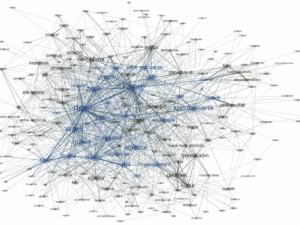Encoding is a key concept in our theory of learning but I continually find that it is under-emphasised in the ‘how we learn’ discourse and in the practice that this translates into in classrooms. I’ve explored this before in various guises. In particular, this post that references the work of Efrat Furst, explains that encoding needs to happen right at the start of a learning process – before connecting to prior knowledge and way before we consider retrieval practice.

In December, Efrat Furst delivered a superb masterclass as part of our In Action series where she explained the stages of learning using…
Keep reading
You need to make some initial pathways in your brain (some actual physical connections) before we can worry about strengthening them through application and practice.

Other posts where these ideas come up is around the notion of ‘making meaning’ – drawing on Ausubel’s work, as described by Sarah Cottinghatt. ‘Is everyone making meaning? ’ is one of my suggested three checks.

As I explored in a previous blog post, it can be useful to condense the complexity of teaching down to just a few key…

Ever since reading Sarah Cottinghatt’s blogs and subsequent In Action book about Ausubel and meaning making, I’ve found it a massively useful reference point…
The problem I find is that as teachers we often just assume that encoding will happen and that is does happen successfully, simply by asking students to listen, to watch or to complete immediate, low-challenge response tasks where working memory can do the heavy lifting only to find later that this activity seemingly left no trace in long term memory. My wife and I still refer to a terrible series of textbooks we used to use our 1990s science department where the comprehension questions required no meaning-making to happen at all. We caricature it like this:
- Text: An ibble is worth two obbles.
- Question. What is an ibble worth?
There is no need to know what these words mean at all and yet, you can get the answer right.
Very generally, I encounter an awful lot of hoped-for learning where everything feels far too tenuous for all concerned. Too often instructional inputs are far too abstract and language heavy, assuming that students can relate terms and concepts to experiences, imagined scenes, mental models and concrete examples all by themselves. But they generally can’t – and generally don’t. You need to build those things into the instructional sequence. We can assume far too much about students’ capacity to make sense of what we’re saying. I say ‘we’ because I think this is a general issue all teachers experience – and it can obviously be a lot worse in some classrooms than others.
Earlier this year, for example, I saw a science lesson where students were doing word puzzles with terms like bacteria, micro-organism, cellular, virus, microbe, before they had seen any images or examples of these things to provide a concrete basis for the language. You can’t encode the word for something if that something is not part of a schema you’ve already formed from some of the many possible schema-building experiences available:
If a word has nowhere to go – it’s just ibble-obble territory. I was begging the teacher, silently, privately in my head, to show them some pictures!! What are these things you’re getting them to spell? It was interesting conversation later – because he had never thought about learning in this way. He hadn’t even considered how abstract it could feel to his novice students. I was able to share my exchange with the student I’d sat next to who had found the notion of bacteria deeply mysterious and couldn’t picture one – or get a sense of the scale relative to other biological structures in our bodies. She wasn’t doing much encoding…at least, not in a way that would lead to understanding. We discussed the relatively low value of knowing words for things without knowing the things… !
Another recent example (from hundreds I could pick) was in French – I saw a lesson where so many new words, phrases and grammatical concepts were assumed to have been learned from previous lessons, that the teacher was ploughing on to new material with gusto. But around the table I sat on, you could tell they had just checked out. The instructional mode in the lesson gave no room for each and every student to consolidate and practice using the words. The boys around me had to look up everything every time; they had zero recall for any of the words and only a faint flicker of recognition when they found the appropriate word list or sentence builder. As for their accents…. !? (And yes, I do see lessons in other schools where similar students can and do speak with great accents because the teacher makes it normal to do so.).
The problem was that they didn’t need to think hard or generate words from memory – they only had to goal seek from the resources and this didn’t even require them to say the words. You can’t learn a language simply by assembling sentences like a puzzle – never linking meanings to your existing language vocabulary and making connections within the new language. You can’t learn French by just sitting in a room where it’s only other people who are speaking it.
Another general, common and age-old issue is when teachers check in with only a small sample of students and, if those few seem to have grasped things – if their encoding seems to have worked – the teacher moves on, regardless of the reality that multiple students haven’t followed the flow at all and have very little chance to catch up. This shallow sampling is teaching on hope. Those students matter just as much as anyone else but the lesson is not geared towards their learning. At worse, there’s an implicit suggestion that, if they don’t understand, it’s really just too bad – it’s even their fault. I’ve met many teachers who baulk at routines and structures like using whiteboards or doing think-pair-share but don’t have alternative techniques in play to engage all students systematically. In fact it’s really very common for a teacher to take literally one correct answer from one student as a cue to move on. For many teachers this is the absolute default.
What possibly frustrates me the most about this issue is that some teachers will go through the motions of an instructional sequence: explaining, modelling, questioning a few students and setting a task to ‘get things down in our books’ – and then later engage students in a retrieval practice quiz because quizzing has been elevated to being the most important routine. But at no point were students invited to rehearse the ideas; to generate explanations or verbalise their understanding – in a way that secured and checked for that initial encoding. They are not all given time to reveal to themselves whether they’ve understood; there’s no process for revealing misunderstandings or missing links. The encoding might have been widely unsuccessful across the class, but, in the absence of any real-time checking for understanding, those students are still faced with a quiz on this knowledge later on, nominally designed to strengthen retrieval. However – painful but true – you can’t hope to remember something you never really knew.

One of the most common areas of development in schools over the last few years has been in the area of retrieval practice – supporting students to remember what they’ve been taught, gradually, steadily deepening and…
A frequent complaint about this issue is that there isn’t enough time for teaching and practice… but if you then see all this low success quizzing going on, that, to me, is the real waste of time. It feels like we’ve got things the wrong way around. If you cut corners on practice, consolidation and checking for understanding that involves all students during that initial instructional phase – you’re just creating massive gaps from the start and it’s hard to find a way back.
In my Karim and the Bus-Stop Method post, it’s the weakness of initial encoding many years ago that causes the students so many problems later on. Fundamental mathematical concepts have never really made any sense. Anyone who struggles with ½ being 0.5 as a decimal and would write 0.2 instead has very fundamental conceptual problems.
What is the answer?
Firstly, I’d say, it is to adopt a monitoring mindset that nags away at you all the time – who here in this room is unsure? How do I know? How can I find you and help you?
Then it’s to make curriculum sequencing deeply rooted in multi-layered schema-building, emphasising concrete experiences, images and visualisations, multiple examples – creating firm foundations for anything abstract:

I find the concept of schema-building incredibly useful when thinking about curriculum design and teaching. It’s a really a spatial metaphor more than anything physical/concrete – but it has fantastic explanatory power and can help teachers…
Then, it’s to make consolidation and practice involving all students an embedded part of instructional teaching, incorporating lots of repetition in varied ways and just the right degree of scaffolding to ensure each student is securing a high success rate whilst also needing to engage in generative thought processes. The Durdle Door example cited above works brilliantly for this. Generally, practising explaining things is a great idea!

Can you know something and not understand it? Yes. For example, you might know that: The USA has a right to silence under police questioning, where people are…
And finally, it’s to make your teaching responsive: if you find students have gaps and are struggling, you need to address them. You must be ready to go back as well as forwards.
I know this is MUCH easier said than done -but you don’t make progress unless you’re actively seeking to address the issue. In curriculum teams, there should be much more discussion about how to encode ideas relative to discussions about what is on the quiz.



